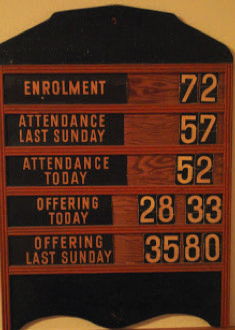
We’ve been talking about the power of church metrics for a few weeks now. The questions we received at our recent webinar show me that there’s a lot of interest in the topic, but a whopping 78% of our attendees classified themselves as either new or fairly new to the journey.
One topic that came up at the webinar was something called Key Performance Indicators (KPIs). These are custom baselines which successful organizations establish to measure themselves against. Don’t worry; this is not as unfamiliar as it may sound.

Low-Tech KPIs
For many years, the church has measured two things: Giving and Attendance. Remember these boards? Or maybe your church still uses one. These were key performance indicators, albeit somewhat ineffective ones.
These numbers served an important, at-a-glance purpose of measuring the most tangible factors available. Then, the board went two steps further by comparing the numbers to the previous week and sometimes the previous year. That comparison made the board the low-tech pioneer of the modern church metrics trend!
Things have changed—and not just in the removal of the numbers board. Peoples’ lives have gotten complicated, society has become less connected, and churches have grown to previously inconceivable sizes. Leaders now understand the power of data for gaining the insights that were previously gained across the fence or dinner table. They know that even if giving numbers seem steady, peoples’ lives may be falling apart and spiritual growth may be non-existent.
New Cuyama’s Fuzzy Math
This popular and funny image makes an astounding point, in my opinion. It shows the way numbers can be collected and manipulated in meaningless ways, which is what we sometimes still do with church numbers.
While the old-school giving/attendance board gave three snapshots that had value, they didn’t really add up to anything, like how many people had come to Christ this year? Were people progressing spiritually toward maturity? How were marriages and families faring in their relationships and communities? How many were in crisis but hiding it in shame?
Back in the day, those things were somewhat easier to know because churches were smaller and members had more visibility into each other’s lives.
Metrics Motivations
While some churches may use metrics in a prideful or fearful way, the only valid reason for using metrics is to improve ministry effectiveness and be good stewards of the resources God has entrusted to us. So, what should we measure to accomplish those goals?
Top 3 Key Performance Indicators
I asked several of our data experts on staff what they believed to be the top three KPIs for churches. Their answers were telling:
Eric Soon, Senior Director of Professional Services and author of our Return on Ministry ebook on this subject, likens KPIs to a tailor-made suit. He states that they should be specific to each individual church’s top three reasons for existence, and that each metric—in order to be valuable—should be made of a contrast, comparison, or combination of metrics.
What does that mean? Scott Lowrie, formerly our F1 Product Manager, gave three examples that explain Eric’s answer:
- Attendance over time by membership status
- Volunteer to attendance ratios over time
- Giving growth over time
Can you see how measurements need to be juxtaposed to fixed factors (like time) or segmented groups (like status) in order to be meaningful?
Mark DeMoss, Senior Manager of Professional Services, humorously summed up the most common measurements churches take:
- Nickels – offerings
- Noses – weekend attendance
- Nudges – spiritual decisions (salvations, baptisms, etc.)
..and adds that KPIs must align with a church’s vision/mission/purpose.
Matt McMaster, Professional Services Consultant, emphasizes factoring in involvement, such as in Groups or Membership, to balance out the top metrics of giving and attendance. Giving and attendance alone provide one snapshot of the church’s health, but they are only two of several factors that help leaders understand individual health.
Bob Van der Ploeg, Professional Services Consultant, offers his top four, to be tracked over time:
Small Group Involvement: Percentage of members/attendees enrolled in small groups.
Visitor Assimilation: Percentage of first time guests that become members/attendees.
Attendance Consistency: Percentage of members/attendees that attend more that 50% of the time.
Volunteer Involvement: Percentage of members/attendee that are actively volunteering.
The Church Metrics Journey
We’ve been emphasizing lately that this is a journey. Wherever you are on this path, there’s room to go deeper, which is to say, to find actionable meaning in the numbers.
As you can see, there are no universal top 3 simple measurements. Rather, Key Performance Indicators should be combination metrics (what we call 2D and 3D) that map to your church’s goals, mission and purpose. (If you haven’t crafted those, start there. Return on Ministry covers these topics in detail.)
Dig a little deeper into the 5 categories that provide meaningful metrics in our Measuring What Matters Most whitepaper.



